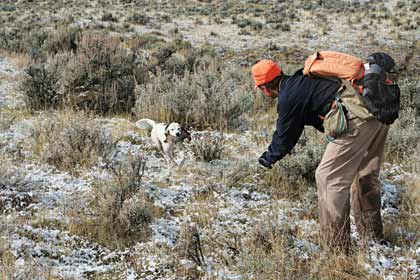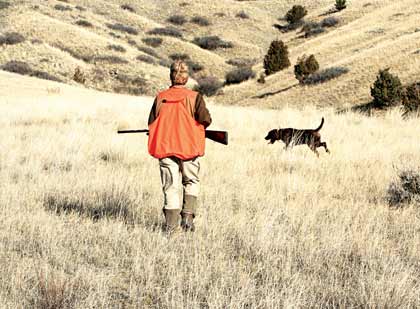Are Hungarian Partridge The Most Underrated Gamebirds In The West?
By Dave Carty
As I write this, I've had three days of blessed rest since my return from a hugely fun, but not particularly relaxing week of chukar hunting in eastern Oregon, an experience that, as ever, infuses my very being with a whole new perspective on Hungarian partridge. To wit: Huns are easy.
Huns are the homeboys in my neighborhood. From here on out, I can look forward to climbing 200- to 300-foot hills instead of scrambling straight up vertiginous 500-foot cliff faces in Oregon; walking three to five miles in an afternoon instead of six, seven, eight or 10; and sprinting after my dogs as they try to pin Huns that run, but then actually hold for a point, as opposed to chukars that run to the top of a ridgeline and then, when you're just all but not quite within range, fly to the top of the next ridgeline over, which is just all but not quite two miles away across a bottomless gorge.
So what's not to like about Huns? Despite their mild manners, I still can't sell the Hun experience. If Hungarian partridge were product, it wouldn't be moving.
Huns may be the most underrated and under-appreciated gamebird in the U.S. I suspect even blue grouse get hunted more than Huns, although admittedly more blues are shot by elk hunters for camp meat than for sport.
But you're not going to hear me complain. While most of the rooster-heads in Montana, the Dakotas, Washington, Oregon and Idaho beeline for the nearest cornfield when the pheasant season opens, Hun hunters can go just about anywhere secure in the knowledge that they probably won't see another Hun hunter all week, if not all season. There are, of course, good reasons for this. As tough as pheasants can be to hunt, in good cover you can usually count on seeing at least a few birds. But forget all that with Huns. You can--and I've done it quite often--hunt half a day in prime cover and never move a covey.
A pair of back-to-back hunts I had two years ago are a case in point. It was midway through the season, cool but not cold, and a steady breeze was blowing toward the river, two miles away. I fitted my setter and Brittany with collars and turned them loose.
They found the first covey near a fence corner. The birds flushed over my head and I managed to drop one that fell a few dozen yards from a creek. As the dogs raced over to pick it up, they ran directly through another covey, which flushed straight up and then sailed downwind, squeaking like a chorus of rusty barn hinges.
Things were looking up. I'd hunted this particular ranch for more than a decade, and during banner years had found as many as four or five coveys on the place. Today, as it turned out, would be even better.
Three hours later, as an orange sun settled into a notch on the horizon, we'd put up, by my best estimate, eight or nine individual coveys. Huns were everywhere--in the rose hips and snowberries along the stream, in the sparse grass above, and in the wheat stubble bottomlands. My Brittany located a covey halfway up a hillside so steep she kicked out mini avalanches of rock and dirt as she scrambled uphill after them, and I had no choice but to follow, clutching at clumps of sagebrush to pull myself up.
 The author's setter brings in a Hun. |
On the far side of that hill, less than 200 yards from a highway, the dogs pointed covey after covey in the stubble hard by a dry coulee thick with rattling canes of hemlock. I didn't shoot many birds--that's a sore subject and I'd rather not go into it--but it was a banner day nonetheless. In fact, for sheer numbers, no other hunt that year came close to it.
A week later I was back with a friend. Joe trains Labs in the next town over, but he was itching for a hunt over pointing dogs. I promised him a good one, and without letting the exact numbers slip--I'm superstitious as a Haitian witch doctor when it comes to making predictions--I figured that, even if we got into half the coveys we'd put up the week before, we'd be in pretty good shape. Three hours later, after combing every inch of that ranch, the dogs finally got their first, and only, point. The birds went up, Joe and I both shot twice, and two Huns fluttered to earth, one for each of us.
Where had all the coveys gone? More important, where had they all come from the week before? Until that lone covey, the dogs hadn't even got birdy. How is it that two experienced dogs found only one of the eight or nine coveys that I know are there? This, among many other things about the birds, beats the heck out of me.
Like their cousins the chukars, Hungarian partridge have done well on this side of the pond. Unlike chukars, though, Huns have a pronounced liking for agriculture, particularly the wheat and barley fields in the Northwest and West. Habitat can vary considerably from one area to the next--I'll touch on that in a moment--but the unifying thread is usually grain stubble of some sort or another. Although I find birds in pure stands of grass, a hilly, grass/sagebrush mixture bordering a wheat field is better. I'd say 90 percent of the Huns I've flushed in the last two decades have come from such areas, which makes it all the more surprising when they don't.
In September, the prairies are like an oven--burned white by the sun, with more than enough rattlesnakes to keep things interesting. For that reason, I've spent the last five or six Septembers hunting blue grouse in the much cooler mountains. A couple years ago, John Palmer and I were climbing toward a spring that sometimes held both ruffed and blue grouse, when my setter went on point in a steeply sloping mountain meadow just below us. We were a bit farther from the woods than I would have considered typical, but it never occurred to me that the birds she'd found would be anything but blues.
--"That's them,--" Palmer said. --"Huns.--"
Sure enough, when the two of us walked past my dog, a small covey swirled up and John swung through them with his English double, dropping one in a puff of russet feathers. We were 6,500 feet up, 1,500 feet above the valley floor, which I could see a good five miles distant. Nor was this a fluke. According to Palmer, that covey had been living there for years, braving deep winter snows, at least one bird hunter with a Hardy side by side, and for all I know, wolverines. Hungarian partridge, it turns out, are where you find them.
 Huns are fair game for pointing dogs like this pudelpointer. |
Like most gamebirds that are uncommonly hunted or written about, Hun hunting abounds in myths. Take it from a distinctly unmythical wing shot, Huns are not, despite what you may have read, difficult to kill. There's no need to resort to high brass loads of 4s or 5s--or high brass loads of any size--no matter how late in the season you hunt them. Shot from 6 to 71„2 will kill a Hun as far as you can hit it, which for me is about 35 to 40 yards. For the last couple years, I've been using an ounce of hand-loaded 7s, but I'm planning to switch to a 7„8-ounce load as soon as my one-ounce loads run out.
For the record, I've killed several birds at 50 yards plus, each a result of bad range estimation and pure, unadulterated luck. My suggestion, for what it's worth, is this: if you don't think you can hit the bird, don't shoot at it.
Do try hunting in the snow and wind, however. For some reason, scores of hunters are convinced Huns can't be approached late in the season, when there's snow on the ground and the wind is making the birds --"jumpy.--" I have no clue how that rumor got started but I'm here to tell you it just isn't so.
First of all, Huns are always jumpy. Last October I was hunting with a friend and his pudelpointer, Scooby Do (no kidding, that's really his name), and he pointed one covey three times before we finally lost it for good. It wasn't until the last flush that we got within marginal shooting range, at which point I was standing between the birds and the dog's owner, Eric, who elected not to shoot my head off and for which I am appropriately grateful.
But the next bunch was a different story. I was directing my friend to move down into a ravine where I'd put up birds before, hoping to snap a shot or two with my camera. Sure enough, the birds were there, and after Scooby pointed and the covey flushed, the whole lot of them flew by about 20 yards out. We watched them land halfway up a hillside, and upon following them up, Eric stepped squarely into the middle of the covey, which, from where I was standing, seemed to get up all around him. The wind, by the way, was howling during the entire hunt.
I've had many similar experiences in the snow. In fact, I've hunted in snow so deep that the birds burrowed into the stuff like so many pint-sized ruffed grouse. At other times I've watched my dogs point at an expanse of unbroken white, only to find the covey a few scant yards from the dog's nose, hunkered down in troughs they'd scratched out to feed on waste grain.
As my focus has evolved from poor shooting to good dog work, I don't kill nearly as many Huns as I used to, even though I hunt more now than I ever did. A big part of that reason is because rather than marking flushed coveys for a follow up, I'm keeping much closer tabs on my pointers, making sure they toe the line. But you certainly don't have to do it that way.
If you see a flushed covey land, you have an excellent chance of putting them up again. Hustle on over there. A word of warning, though: Huns fly a long ways, and unlike chukars, they usually fly uphill. What's more, they may or may not hold on the reflush. In fact, they may never hold. But then again, they just might come up around your pants legs.
Just so you know.






